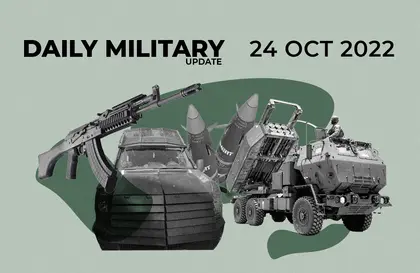The Russian Federation’s (RF) “evacuation” of regions, towns and villages surrounding the southern city of Kherson continues on Oct. 24. Independent observers predict that the Kremlin plans to fight a battle on its terms inside the city by attempting to draw better-armed and motivated Ukrainian army units into a bloody urban battle.
Steady movements of civilians from the right to the left bank of the Dnipro River by ferry and pontoon bridges was widely reported over the weekend, as were Armed Forces of Ukraine (AFU) long-range rocket strikes on the only Dnipro crossing site still reportedly usable by vehicles. This is close to a hydroelectric dam near the city of Nova Kakhovka.
JOIN US ON TELEGRAM
Follow our coverage of the war on the @Kyivpost_official.
Vladislav Seleznov, a spokesman for Ukraine’s Army General Staff (AGS), said in an interview with Channel 5 Television on Oct. 24 that, although the Kremlin was moving civilian officials and some military equipment to relative safety on the left/southern bank of the river, the Russian army has no intention of leaving the right/northern bank without a fight. As such, he warned that it was concentrating many of its best troops for a last-ditch battle inside Kherson city itself.
“The Russians are actually moving [some] troops and equipment to the right bank [into Kherson city]… there will be a battle.”
Latest ground movements
Both Ukrainian and RF-controlled media over the weekend reported new AFU advances and measured RF army “evacuations” of villages along the line of contact.

Will Trump’s Attitude to the War in Ukraine Differ Second Time Around?
The Washington-based Institute for the Study of War (ISW) in an Oct. 23 situation estimate confirmed that RF units had abandoned the villages of Charivne and Chkalove, while rear area RF military personnel such as officers and medics were “evacuating” the town of Beryslav. Ukrainian news media reports generally confirmed the ISW evaluation.
Artillery exchanges were reported on Oct. 23 across the southern front, with RF artillery strikes hitting more than 20 AFU-held cities, towns and villages including Bezimenne, Bilohirka, Davydiv Brid, Novohryhorivka, Novoukrainka, Partyzanske, Pravdyne, and Chervona Dolyna.
According to statements and images published by the Georgia Legion – an AFU unit manned largely by Georgian volunteers – Ukrainian forces captured the village of Mylove on Oct 23.
Some Russian army social media appeared to confirm Ukrainian predictions that the Kremlin wants to pull troops in from field positions across the Kherson sector to prepare for battle inside the city.
In a Telegram channel used by members of the 205th Separate Mechanized Infantry Brigade, an RF unit operating in the Kherson sector, a poster warned fellow service personnel: “I hope that during the withdrawal, the enemy [AFU] will not make concerted ground assaults or long-range attacks with aviation or HIMARS artillery. The better things are planned and organized, the less [RF] losses there will be. So far, I am not pleased with our routes [of withdrawal]. The terrain is open.”
Kyrylo Budanov, a spokesman for the Ukrainian army Main Directorate of Intelligence (MDI) said that the Russian army leadership hopes to draw the AFU into close-in fighting inside Kherson. The aim is to reduce the effect of the AFU’s critical advantage in long-range, precision-guided munitions, and to inflict massive casualties on Ukrainian units in close-in infantry battles.
“They [RF forces] are creating the illusion that everything is lost. And at the same time, they are bringing in new military units and preparing the streets of the city for defense,” Budanov said in MDI-published comments.
“It’s absolutely clear what the Ukrainian forces need to do. They need to destroy those routes that are providing military logistics that support movement of troops to the right bank…The more they are hit on the right bank, the less there will be to conduct a counterattack later,” Seleznov said.
State of RF forces
Seleznov and most military analysts estimate the RF army still fields around 30,000 trained troops in and around Kherson. Many are in elite fighting units like marines and paratroopers capable of fiercely defending a city.
In recent months, in open steppe fighting, RF units have performed relatively poorly against AFU units who, by many accounts – including by AFU soldiers themselves – are better armed, trained, combat experienced and motivated to fight than their Russian opponents.
According to observers, RF regular army troops in Kherson are complemented by soldiers recently mobilized and sent to the front following Russian President Vladimir Putin’s late September call-up of as many as 300,000 reservists. Placement of the poorly trained former civilians – widely called “mobiks” – In a sacrificial, first line of defense is a widely-reported RF army tactic.
In a possibly related development, the Kremlin-financed RIA Novosti television channel, on Oct. 24 informed viewers i that local authorities were forming territorial defense battalions manned by civilian volunteers, to help the Russian army defend the city.
Loss of services
Meanwhile inside Kherson, internet users reported an almost total failure of cable and high data volume service on Oct. 23. According to a statement by Skynet Kherson, one the city’s largest providers, RF occupation authorities were “transferring communications equipment” and, as a result, high connectivity service across the entire region was turned off indefinitely. Some users reported limited bandwidth service still operational via mobile phones, at scattered locations.
Ukrainian blogger Konstantyn Ryzhenko published images on Oct. 24 reportedly showing completely severed Kherson fiber-optic trunk cables in an underground access node. Widely forwarded images from Kherson grocery stores showed shelves picked clean of food and supplies.
Some fuel stations in occupied Kherson had ceased operating completely, while others were selling gasoline and diesel only to motorists willing to pay in Ukrainian hryvnias. Russian occupation authorities declared the Russian ruble the region’s “main” currency back in April.
You can also highlight the text and press Ctrl + Enter






